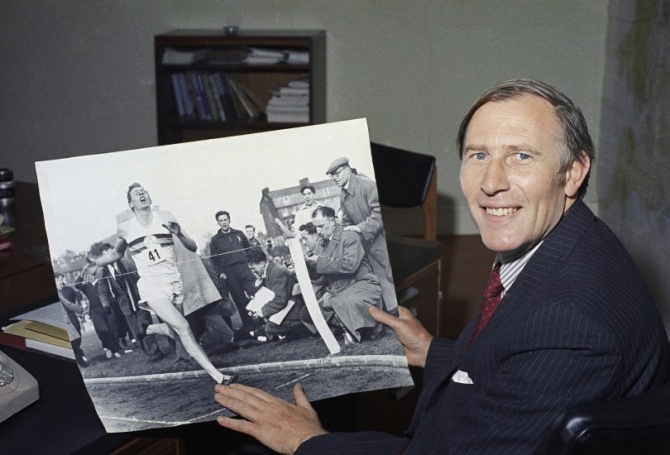Roger Bannister dies; first to break 4-minute mile

By Anne Kenderdine, (c) 2018, The Washington Post
Propelled by an ever-lengthening stride and extraordinary willpower, the lanky British medical student Roger Bannister became the first person to run a mile in less than four minutes. He pitched over the finish line at the University of Oxford’s Iffley Road track on a dank, blustery day – May 6, 1954 – and electrified England during its post-World War II doldrums.
Bannister, who died March 3 at age 88, became a national hero at a time when mavericks around the world were overcoming the long-perceived physical boundaries of man and nature.
The American pilot Chuck Yeager broke the sound barrier in 1947, and the New Zealand mountaineer Edmund Hillary and his sherpa Tenzing Norgay conquered Mount Everest in 1953. Then came Bannister, with his astonishing 3-minute, 59.4-second run.
His milestone resonated with millions of people for its seeming simplicity: four laps, four minutes, the universal endeavor of running made into a sublime feat.
“It was amateurism’s last hurrah,” Christopher Chataway, one of Bannister’s training partners and pacesetters, told The Washington Post in 2004. “Roger and our group were the last generation who were lucky enough just to be at the top of the sport while having it only as a recreation.”
Bannister was racing against time in more ways than one: He knew that American Wes Santee and Australian John Landy also had made the four-minute mile their goal and wanted to beat him into the history books. “It all came down to whoever had the first chance in tolerable weather,” Bannister recalled to the New Yorker decades later.
Landy surpassed Bannister’s world record less than seven weeks later, clocking 3:58.0 minutes in Turku, Finland, on June 21.
At the British Empire and Commonwealth Games in Vancouver on Aug. 7, 1954, Bannister and Landy raced each other for the first time, in a pack with six others.
The oddsmakers picked Landy’s endurance to win over Bannister’s smoldering kick. Bannister closed a risky gap to finish five yards ahead of Landy with a time of 3:58.8 minutes to Landy’s 3:59.6.
Amid the international frenzy about the mile title, Bannister completed his medical studies in June 1954 at St. Mary’s Hospital Medical School in London.
Two months later, he claimed the European title for the 1,500 meters in Bern, Switzerland. He ended competitive racing at age 25, having never earned prize money, to focus on his career as a neurologist.
All but a few months of his training coincided with the 14 years of food rationing in England during and after World War II. “All that training was done on a limited diet,” Bannister once said. “I cannot understand people who are nostalgic for the 1950s – they were very tough times.”
Roger Gilbert Bannister was born in Harrow, now a borough of London, on March 23, 1929, and he spent part of his childhood in Bath. His father was a government auditor.
His childhood and teen years found him sprinting up the steps of Beechen Cliff on his way to school in Bath, hiking 10 miles a day as a summertime tour guide, and biking the 100-mile trip from Bath to London in a day to visit a friend as a 13-year-old.
“I just ran anywhere and everywhere – never because it was an end in itself, but because it was easier for me to run than to walk,” he told authors Cordner Nelson and Roberto Quercetani for their book “The Milers.”
He entered Oxford’s Exeter College, and his diligence in shoveling snow off the Iffley Road track scored him a spot as a third-string miler in the meet with rival Cambridge, held on the day before his 18th birthday.
In the back straight of the final lap, he once recalled, “I had suddenly tapped that hidden source of energy I always suspected I possessed.” He won in 4:30.8.
He completed his undergraduate degree in 1950 and, by 1951, he held the British national title in the mile and was readying for the 1952 Helsinki Olympics. He was favored to win the gold for Britain in the 1,500. Instead, he placed fourth, and his crushing disappointment motivated him to pursue the four-minute mile and break Swedish runner Gunder Hägg’s record of 4:01.4, which had stood since 1945.
As an amateur competitor focused on his studies, Bannister trained about 25 miles a week, much less than today’s elite middle-distance runners, and for many years he was essentially self-coached.
Determined to break the sub-four-minute mile, he began training in late 1953 with Austrian-born coach Franz Stampfl. Stampfl had Bannister, Chataway and their friend Christopher Brasher run 10 laps of 440 yards – a quarter mile – with a two-minute recovery between each.
From December 1953 to April 1954, the trio reduced their time for the quarter from 66 to 58.9 seconds. They were poised for the record attempt.
On the day of his four-minute mile in the Amateur Athletic Association vs. Oxford meet, Bannister saw patients at the hospital, used a laboratory grindstone there to sharpen his spikes and had ham salad for lunch with a running friend from his freshman year.
…
